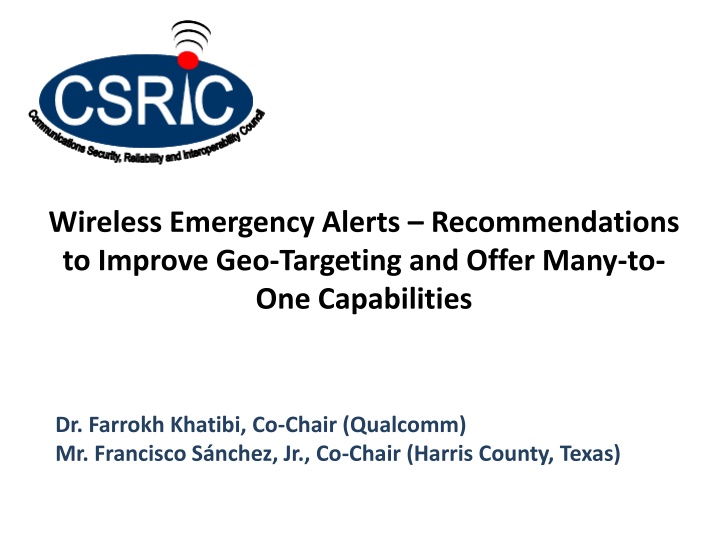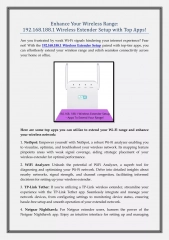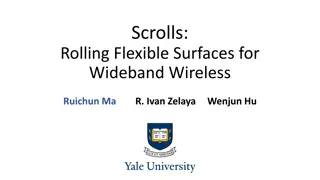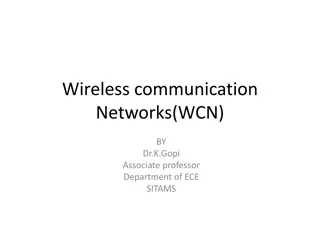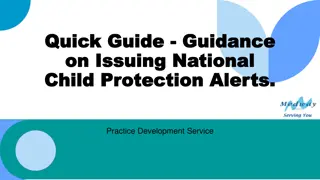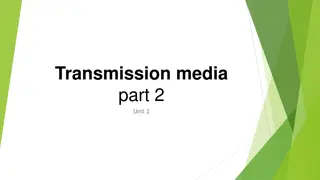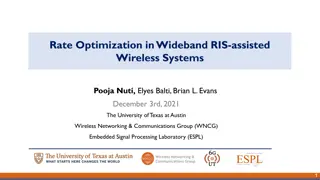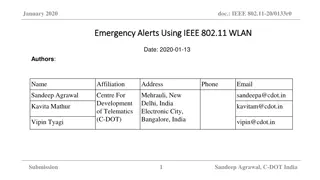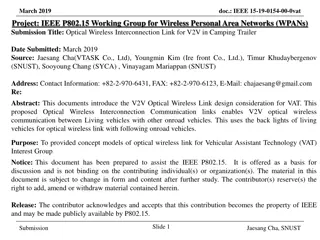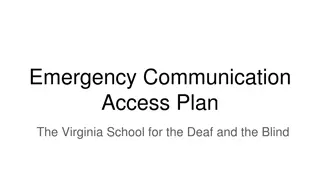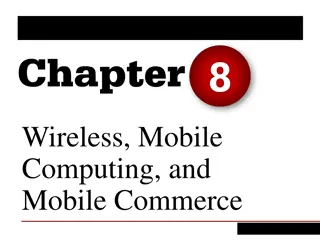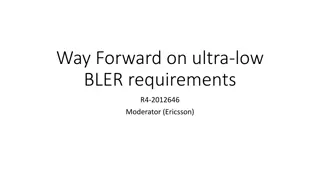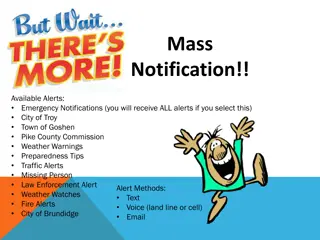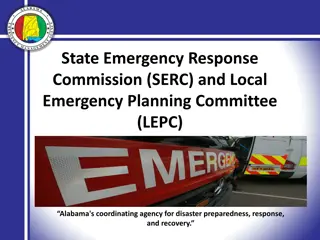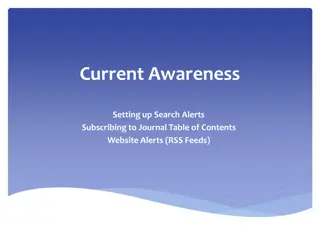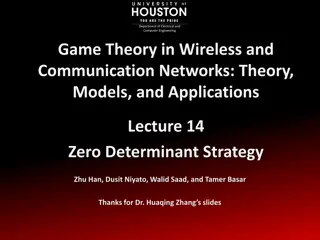Improving Wireless Emergency Alerts for Targeted Communication
This presentation highlights recommendations to enhance geo-targeting and many-to-one capabilities in wireless emergency alerts. The working group's objectives, deliverables, recent events, and findings related to encouraging the use of emergency alerts are discussed, emphasizing the importance of effective communication during critical events.
Download Presentation

Please find below an Image/Link to download the presentation.
The content on the website is provided AS IS for your information and personal use only. It may not be sold, licensed, or shared on other websites without obtaining consent from the author.If you encounter any issues during the download, it is possible that the publisher has removed the file from their server.
You are allowed to download the files provided on this website for personal or commercial use, subject to the condition that they are used lawfully. All files are the property of their respective owners.
The content on the website is provided AS IS for your information and personal use only. It may not be sold, licensed, or shared on other websites without obtaining consent from the author.
E N D
Presentation Transcript
Wireless Emergency Alerts Recommendations to Improve Geo-Targeting and Offer Many-to- One Capabilities Dr. Farrokh Khatibi, Co-Chair (Qualcomm) Mr. Francisco S nchez, Jr., Co-Chair (Harris County, Texas)
Working Group 2 - Roster Dr. Farrokh Khatibi Qualcomm Matthew Straeb GSS/ALERT FM Mr. Francisco Sanchez Jr. Harris Co. (TX) Emergency Management Brian Murray Harris Co. (TX) Emergency Management Hutch McClendon Advanced Computer and Communications Charity Dominguez Harris Co. (TX) Emergency Management Elizabeth T. Dexter Arlington VA OEM Tony Surma Humanitarian Toolbox Brian Daly AT&T Bob Sherry Intrado Peter Musgrove AT&T (ATIS) David Layer National Association of Broadcasters Jonathan W. Gaddy Calhoun Co. Alabama EMA Larry Walke National Association of Broadcasters Caitlin Shockey Centers for Disease Control Benjamin J. Krakauer New York City Emergency Management James Tyson Centers for Disease Control Robbie Turner Nextdoor Dara Ung Comtech Robert Bunge NOAA Dr. Keith Bhatia Comtech TCS Mike Gerber NWS Denis A. Gusty DHS, S&T/FRG Dana Golub PBS Jose Rivera DHS/OEC Mark D. Annas Riverside (CA) Fire Dept Dr. Gina M. Eosco Eastern Research Group Dr. Carol Woody Software Engineering Institute Alexander Gerdenitsch Echostar Brad Gaunt Sprint Jennifer Manner Echostar John Davis Sprint Scott Enright Emmis Communications Shelley Blakeney T-Mobile Christopher Tarantino Epicenter Media & Training Tim Dunn T-Mobile Paul Lupe Fairfax County VA OEM Amanda Faulkner Twitter Chris Anderson FCC Dr. Jeannette Sutton University of Kentucky Greg Cooke FCC Dharma Dailey University of Washington James Wiley FCC Kate Starbird University of Washington Alfred Kenyon FEMA IPAWS Amanda Hughes Utah State University Mark Lucero, CISSP FEMA IPAWS Larry Rybar Verizon Rick Wimberly Galain Solutions Xiaomei Wang Verizon 2
Objectives The Subgroup was tasked to provide recommendations on how best to encourage the use of emergency alerts by state and local officials at a local/geo-targeted level, including leveraging different alerting platforms and the coordination of information flow from both one-to- many and many-to-one . 3
Deliverables Working Groups drafted recommendations in the following areas: 1. Geo-targeting (Encouraging WEA Usage) 2. Many-to-One Communications Systems Final Alerting Report was submitted Friday, August 26, 2016 4
Recent Events Orlando Nightclub Shooting Miami Zika Outbreak Paris Attacks Baton Rouge Flooding Hurricane Sandy 5
Findings: Defining Best Approximate Highly dependent on topography, density of cell towers, environmental conditions, time of day) In densely populated cities, the alert is broadcast to nearly all of the actual alert area due to the high density of cell towers which broadcast the alert. Anecdotal information suggest the alert broadcast may reach locations about up to about 2 miles outside the actual alert area. In suburban areas, there are typically small pockets where pockets with limited/no cell tower coverage where WEA does not reach those areas. Anecdotal information suggests the alert broadcast may reach locations up to about 5 miles outside the actual alert area. In rural areas, there are the greatest number of areas with limited/no cell tower coverage where WEA does not reach those areas. The alert broadcast from boomer towers reach locations 30,000 meters (approximately 20 miles) or more outside the actual threat area. 6
Additional Findings 1. The FCC should adopt expanded message capacity as recommended by CSRIC IV in order to accommodate nearly all future WEA enhancements. ATIS/TIA confirmed this is technologically possible in Feasibility Study for LTE WEA Message Length in October 2015 and recommends a maximum permissible message length 360 characters. 2. Message granularity must be improved in order to help build system trust among both AOs and the public. A balance must be established between the capability and impacts to technology within the CMSP network, mobile devices, device OSs, and the desires of the AOs. 7
Recommendation 1 Recommendation 1: It is recommended by Working Group 2 that the FCC modify existing county-level down to cell level, with best approximate then being defined as covering as much of the AO specified polygon as possible with minimal overshoot or undershoot, given the technical challenges posed by cell site topology and RF propagation. 8
Recommendation 2 Recommendation 2: It is recommended by Working Group 2 that alert originators determine the granularity of alert areas using vertices with two to five decimal places depending on the nature of the hazard. 9
Recommendation 3 Recommendation 3: It is recommended that by Working Group 2 that the FCC collaborate with ATIS, CMSPs, AOs, geo-targeting experts, device manufacturers, and other subject matter experts to conduct research, develop standards and implement systems that support enhanced geo-targeting and allow device operating systems and device based applications to do the following: Identify methods to transmit the polygon coordinates to the mobile device using cell broadcast o While supporting the legacy WEA system for existing deployed devices as well as newer, enhanced WEA service for new devices o Methods need to be standardized internationally to support roaming 10
Recommendation 3 (cont.) Identifying changes needed to cell broadcast to allow a received cell broadcast message containing the coordinates to be passed to an OS or device based WEA application (Changes needs to be made on an international basis to support roaming) Understanding the full impacts on the network by the device determining its location using A-GPS or other location technologies. Use the polygon of the alert area embedded in the WEA message to help the device determine if it is inside the alert area. If the device is determined to be inside the alert area, the alert is rendered on the device depending on the configuration of the user location and alert preferences on the mobile device. In the event the device is unable to obtain location information as described above, within a predetermined amount of time, the alert is displayed on the device in plain text form depending on the configuration of the user location and alert preferences on the mobile device. 11
Recommendation 3 (cont.) Render the alert on compatible devices in a manner that provides a map clearly illustrating the alert area, the location of the device (if known), and any additional relevant life-safety information depending on the configuration of the user location and alert preferences on the mobile device. Provide an archive of the alert so that WEA recipients may reference the relevant previous message content. This should be completed within up to 18 months of an FCC Report and Order on this document with a full outline of issues developed and presented to the key stakeholders, including the FCC, within 6 months of commencement of work. Once the standards work is complete, full system deployment including new handsets should be deployed within no more than 24 months. 12
Recommendation 4 Recommendation 4: Working Group 2 strongly recommends that the FCC expedite modifying 47CFR 10.430 Character limit as follows: A WEA Alert Message processed by a Participating CMS Provider must not exceed 90 characters of alphanumeric text for 2G and 3G, and 360 characters of alphanumeric text for 4G LTE and later technologies. 13
Recommendation 5 Recommendation 5: It is recommended by Working Group 2 that FCC collaborate with ATIS to lead a development group comprising of CMSPs, AOs, FEMA, device manufacturers, OS providers, and other subject matter experts to create a set of minimum specifications for an enhanced, secured and trusted, standards-based, CMSP- controlled WEA mobile device based application which can be developed, tested, and deployed under strict guidelines adopted by CMSPs and their device manufacturers and OS providers and not modifiable by the consumer, while maintaining CMSP control of the customer experience in order to ensure high level support. 14
Recommendation 6 Recommendation 6: It is recommended by Working Group 2 that FCC collaborate with ATIS to convene, within 6 months of the adoption of this report, a public-private partnership comprised of the wireless industry, device manufacturers, academics, and AOs to further the concept of Many to One outside the WEA regulatory framework. 15
Recommendation 7 Recommendation 7: It is recommended by Working Group 2 that, within 18 months of the adoption of this report by CSRIC V, the FCC collaborate with ATIS and CTIA study and evaluate potential back- end mechanisms to passively collect and share geo-fenced usage data with emergency management stakeholders. 16
Recommendation 8 Recommendation 8: It is recommended by Working Group 2 that FCC request that ATIS develop standards enabling the inclusion of Uniform Resource Locators (URLs) into WEA messages, if determined to be feasible by studies currently underway. 17
Items for Further Discussion Throughout this process, the issue of CMSPs or other entities withdrawing from the WEA program has arisen. The FCC should consider whether it is necessary to outline a mechanism to affect withdrawal with minimal disruption to the system and public safety outcomes. The FCC should consider convening a panel of subject matter experts from the alert origination committee, wireless providers, academia, researchers, and device manufacturers to consider the next generation of Wireless Emergency Alerts (WEA 2.0). This panel should begin work within 18 months of adoption of this report by CSRIC V. CSRIC VI should consider how new technologies can be coupled with WEA to serve the Access & Functional Needs community. 18
THANK YOU QUESTIONS? 19
